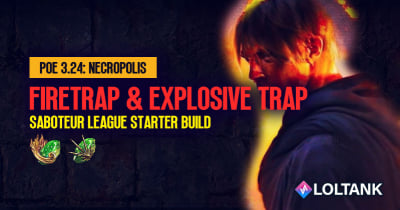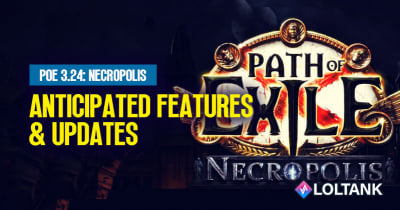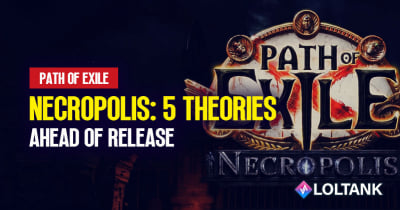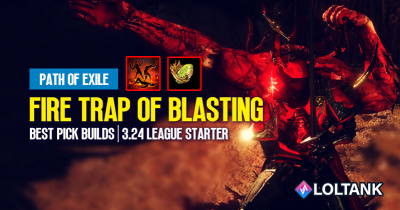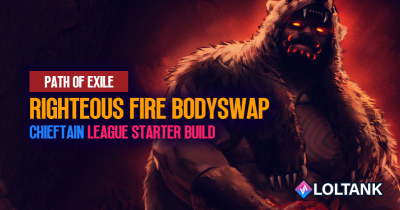Path of Exile Ultimate Beginner Guide: Everything You Need To Know
- Davion
- Share
- Path of Exile
- 11/27/23
- 1715
Hey, new Exile! Lost in the sprawling world of Path of Exile? Fear not! Our Ultimate Beginner's Guide is like your personal GPS in this RPG wonderland. We'll be your torch in the dark, guiding you through leagues, classes, and game modes. Wondering how to defeat that daunting boss or build an unbeatable character? We've decoded the game for you (no actual cheat codes, just smart tips!).
- Campaign & Basics
- Selecting A Character
- First Steps
- Gem Basics
- Attributes
- Item Sockets, Links & Colors
- Currency System
- Item Rarity
- Passive Skill Tree
- Flasks
- Auras
- Crafting Bench
- Ascendancy
- How to unlock Your Ascendancy?
- Spells vs. Attacks
- "Increased" vs. "More": What's the Deal?
- Armour, Evasion, & Energy Shield
- Resistances
- Mitigation, Avoidance, & Recovery
- Ailments
- Chapter 2: Endgame & Atlas
- Chapter 3: League Mechanics
- Chapter 4: Miscellaneous. Monetization
- Stash Tab Tier List
- Affinities
- Loot Filters
- Optimal Game Settings
- Pantheons
- Corruption
- Divination Cards
- Trading
- Signing Off
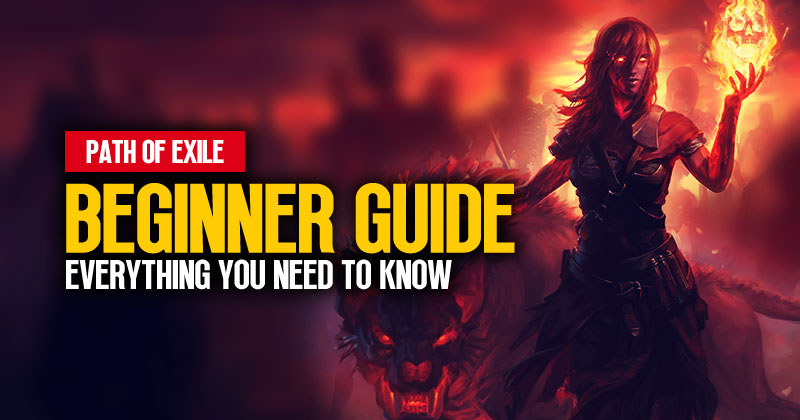
↖ Campaign & Basics
- Challenge Leagues: These are 3-4 month cycles of new content. It's recommended for new players to start here instead of the Standard league, which has a more inflated economy.
- Hardcore vs. Softcore: For beginners, starting with softcore is advised due to the game's challenging nature. In hardcore, death leads to significant penalties.
- Solo Self-Found (SSF): This mode prohibits trading, relying solely on crafting and loot drops. It's more challenging but can be rewarding.
- Ruthless Mode: This mode is for highly experienced players and is not recommended for beginners.
↖ Selecting A Character
- Classes: There are seven classes, each with unique starting points on the passive skill tree and specific ascendancies (sub-classes).
- Build Guides: Using build guides is recommended for beginners to reduce the complexity of character building.
- Freedom of Choice: Every character can use any skill, but their effectiveness varies based on the class and build.
| Class | Description |
|---|---|
| Templar | A battle mage class, good with elemental damage and totems. |
| Shadow | An assassin-type class, fast and damage-focused but less defensive. |
| Marauder | A melee character with strong defense and offense. |
| Scion | Unlocked later in the game, an all-rounder but challenging to use effectively. |
| Ranger | Specializes in bows, speed, and projectiles. |
| Duelist | Attack-focused, versatile for both melee and ranged combat. |
| Witch | The primary caster and minion class, with diverse build paths. |
↖ First Steps
Fear not! This game's like a jigsaw puzzle with a million pieces, and we are here to help you start piecing it together.
- The Interface: First up, you'll see your life globe (pretty important, that one), mana globe, and your flasks – these little lifesavers will keep you chugging along, literally. And yes, there's a shop button, but relax, there's no pay-to-win nonsense here.
- Your First Loot: So you've knocked down your first baddie and got your hands on a shiny new wand and a fireball skill. Remember, any class can use any skill in this game – it's like a buffet, and everything's on the menu!
- Skill Gems: Skills in this game come in the form of gems. You've got to socket these into your gear to use them. And no, weapons aren’t just for attack gems, nor are armor pieces exclusively for defense. Mix and match to your heart's content!
- Linking Gems: Want to spice up that fireball? Link it with a support gem, like Arcane Surge. Just make sure the sockets are linked together. It's like adding hot sauce to your favorite dish – a little extra zing!
↖ Gem Basics
In town now? Great! Let's talk about gems.

- Active Skill Gems: These are your bread and butter. They have tags like 'projectile', 'spell', 'AOE', and 'fire'. These tags are clues for your passive skill tree choices – it’s like a cheat sheet for your build.
- Support Gems: These gems don't create skills but enhance them. They can change how a skill behaves or simply amp up the damage. It's like giving your spells a personal trainer.
- Leveling Gems: Your gems gain XP and level up, just like you. But remember, a gem only levels up if it's in your gear. It's like Pokémon – if it's not with you, it won't grow!
↖ Attributes
Path of Exile has three main attributes: Strength, Intelligence, and Dexterity. Think of them as the game's version of the food pyramid.

- Strength (Red): This is your brute force. It boosts life and melee damage. The more you have, the tankier and punchier you become.
- Intelligence (Blue): The brainy stat. It increases mana and energy shield. It's for those who like casting spells more than lifting weights.
- Dexterity (Green): The agile one. It ups your accuracy and evasion. Perfect for those who prefer a nimble playstyle.
Remember, these attributes aren't just for show. They determine what gear and gems you can use. But don't go crazy over them – it's more about meeting requirements than hoarding stats.
↖ Item Sockets, Links & Colors
Let's talk about item customization.
- Socket Colors: Each attribute has a corresponding socket color – Strength is Red, Intelligence is Blue, and Dexterity is Green. It's like coordinating your outfit – you want the right colors for the right look.
- Socketing and Linking: This is where the magic happens. The right combination of gems in linked sockets can turn your character from a street brawler to a demigod. It's all about creating that perfect synergy.
↖ Currency System
Step aside, standard gold coins; Path of Exile's currency system is a whole other beast. Here, every piece of currency has a dual purpose: trade and craft.

- Chaos Orbs: The bread and butter of the PoE economy, great for mid-level crafting or as trading chips.
- Jeweler's Orbs: Got an item with too few sockets? These orbs add more, but it’s like a slot machine – you never know how many you'll get.
- Orbs of Fusing: These babies are the link-makers. Want to connect sockets on your gear? This is your go-to orb.
- Chromatic Orbs: For the fashionistas of Wraeclast, these orbs change socket colors, ensuring your gear is not only mighty but also color-coordinated.
- Orb of Transmutation: Upgrades normal to magic items.
- Orb of Alteration: Rerolls mods on magic items.
- Orb of Alchemy: Elevates normal items to rare ones.
- Orb of Scouring: Erases all mods from an item, a clean slate for crafting aficionados.
- Pro Tip: Higher level items are tougher to craft, so save your orbs for those perfect rolls.
↖ Item Rarity
Items in Path of Exile come in all shapes and rarities, each with its own charm.
- Normal Items: The vanilla of gear. No frills, no mods, just basic utility.
- Magic Items: A step up, featuring up to two mods. It's like adding sprinkles to your vanilla.
- Rare Items: The showboats, with up to six mods. These items can be game-changers if the mods align with your build.
- Unique Items: The unicorns of Wraeclast, each unique item has fixed properties that can define or complement your playstyle.
- Remember: Rarity isn't always king. Sometimes a well-rolled Rare can outshine a Unique.
Item Quality: Boost your gear's performance with Armourer's Scraps, Glassblower's Baubles, and Blacksmith's Whetstones! These items increase the quality of your gear, enhancing their effectiveness. However, magic items only gain half the quality boost, while rare or unique items improve by just 1% per item. Running low on resources? Trade these quality items for Scrolls of Wisdom.
↖ Passive Skill Tree
The Passive Skill Tree in Path of Exile is less a tree and more a sprawling forest.

- Class Determines Start Point: Your class decides where you start in this forest. Witches head to Intelligence, Marauders to Strength, and so on.
- Nodes Galore: Small nodes are your stepping stones, leading you to the juicy Notable nodes – these are your major power-ups.
- Masteries and Keystones: Masteries allow fine-tuning within a path, while Keystones are the wild cards, offering powerful buffs with potential drawbacks.
- Jewel Sockets: These are your customization hotspots. Insert crafted Jewels for that extra edge or to fill in your build’s gaps.
- Follow a Guide: Seriously, unless you’re a PoE veteran, a build guide is your best friend.
↖ Flasks
Forget everything you know about potions in RPGs. Flasks in Path of Exile are game-changers.

- Life and Mana Flasks: Basic but vital. Keep them updated as you level up for maximum efficacy.
- Utility Flasks: Here's where the fun begins. Want a speed boost? Quicksilver Flask. Need more evasion? Jade Flask. The possibilities are vast.
- Strategic Recharge: Flasks recharge as you defeat enemies, adding a layer of strategy to your dungeon romps.
- Customizable: Flasks can be modified with mods, tailoring their effects to your needs.
- Vendor Trading: Outgrown a flask? Trade it up at a vendor for something more fitting your level.
↖ Auras
Moving on to auras. These aren't just flashy lights; they're game-changers. Auras are special skill gems that give passive buffs, but they come at a cost – they reserve a chunk of your mana. But hey, no pain, no gain, right? The trick is to balance your mana reservation with your need for casting spells. Some builds even go all-in, reserving all their mana and using lifetap support to cast using health instead.

There's a variety of auras, some reserving a percentage of mana, others a flat amount. And for the daredevils out there, pair an aura with the arrogance support, and you can reserve life instead of mana. Just tread carefully!
↖ Crafting Bench
The Crafting bench is your go-to for customizing gear with that perfect mod, like adding fire resistance to gloves. Available throughout your journey, these benches let you tailor gear to your needs. Remember, crafted mods are temporary fixes until better gear comes along. Overwriting a mod? You'll need an Orb of Scouring.
↖ Ascendancy
And now, the moment you've been waiting for – choosing your Ascendancy class. Each class in Path of Exile has unique Ascendancies, offering a smorgasbord of skills and bonuses.
- Templar: Choose between the Guardian (a support/tank hybrid), Hierophant (totem-based caster), or Inquisitor (critical strike and elemental damage maestro).
- Shadow: Opt for the Assassin (high damage, single-target specialist), Saboteur (traps and mines expert), or Trickster (jack-of-all-trades with speed and recovery).
- Marauder: Go Berserker for raw damage and speed, Juggernaut for ultimate tankiness, or Chieftain for fire-based mayhem.
- Ranger: Dead Eye for archery excellence, Raider for speed and evasion, or Pathfinder for flask-based shenanigans.
- Duelist: Champion for a balanced powerhouse, Slayer for leech and AoE dominance, or Gladiator for bleeding and blocking expertise.
- Witch: Elementalist for elemental ailments, Occultist for cold/chaos magic, or Necromancer for minion mastery.
- Scion: The jack-of-all-trades, master of none, offering a mix of other classes' perks.
Remember, each Ascendancy shapes your playstyle dramatically, so choose wisely!
↖ How to unlock Your Ascendancy?
To unlock Ascendancy, your character's ultimate form, complete the labyrinth trials found across the game, starting in Act 3. These trials, filled with dangerous traps, lead to the Aspirant's Plaza and your first Labyrinth run. Be sure to bring life flasks and avoid death to avoid starting over. Successful completion unlocks Ascendancy, enhancing your character's abilities.
↖ Spells vs. Attacks
Ready to crack the damage code in Path of Exile? Let's start with the basics: the difference between attack and spell damage.
- Spells: These guys get their oomph from the gem level. Take Fireball, for example – its damage increases as the gem levels up. No weapon involvement here; it's all about those gem levels.
- Attacks: These are all about your weapon. Ground Slam, for instance, relies on the weapon's stats – physical damage, critical strike chance, and attack speed. So, if you're into attack-based skills, remember: your weapon is your best friend. Keep it sharp and shiny!
↖ "Increased" vs. "More": What's the Deal?
Now, let's demystify the most confusing part of PoE: the difference between "Increased" and "More".
- Increased Damage: Think of this as your cumulative damage boost. It's additive, so all your "increased" bonuses stack together. Sounds great, right? But here's the catch – the more "increased" damage you stack, the less impactful each new addition becomes (hello, diminishing returns!).
- More Damage: This is where the party's at! "More" damage multiplies your total damage. So, if your skill deals 100 damage and you get a 39% "More" damage boost, you're now dishing out 139 damage. Always be on the lookout for these multipliers – they're the secret sauce for insane damage numbers.
↖ Armour, Evasion, & Energy Shield
And now, a quick dive into the defensive side of things:
- Armour: Your go-to for reducing physical damage. The smaller the hit, the more effective the armour. But beware of those big, mean hits – armour's effectiveness dwindles against them.
- Evasion: This isn't just dodging attacks left and right – it's calculated using entropy. So, it's not about luck but more about when you'll evade an attack. Pop a Jade Flask, and watch your evasion chance soar!
- Energy Shield: Think of it as a magical shield over your health. It takes damage first, except for chaos damage (chaos just doesn't care). It naturally recovers after a short break from being hit, and you can even speed up this recovery with the right passive nodes.
Remember, Energy Shield is gear-dependent – it's not a beginner-friendly defense. Armour and Evasion, on the other hand, offer more immediate benefits.
↖ Resistances
Resistances in Path of Exile are your elemental shields. Max them out to 75% to drastically reduce damage from fire, cold, lightning, and chaos elements. For example, with 75% fire resistance, a 100-damage fireball only hits you for 25. You can beef up your resistances with gear mods or the Purity of Elements Aura from Act 3. But watch out, your resistances drop after the bosses of Act 5 and Act 10!

↖ Mitigation, Avoidance, & Recovery
Defense in Path of Exile boils down to three essentials: Mitigation (armor and resistances), Avoidance (evading or dodging attacks), and Recovery (how quickly you heal). Use spell suppression, block, and fortify to lessen damage, and rely on life leech and regeneration to heal up. Keeping your recovery high and flasks ready is key to survival.
↖ Ailments
Path of Exile's ailments are like unwanted guests at a party. You've got ignite (burn damage), shock (increased damage taken), chill and freeze (slowing or immobilizing), poison (toxic damage over time), and bleed (physical damage over time). Some are just pesky, but others, like freeze, can be lethal. Gear up with ailment immunities, either through equipment, flasks, or passive skills.
↖ Chapter 2: Endgame & Atlas
Survived the campaign? Great! Now, meet the Atlas of Worlds, your new playground in Path of Exile's endgame. Start by visiting Commander Kira in the epilogue to begin your mapping journey.
Map Showcase
In the Atlas, each map is a unique adventure with its own layout, monsters, and bosses. Use your map device in your hideout (thanks to Commander Kira) to start these mini-adventures. Remember, focus on the bosses for the best loot, including more maps!
The Atlas of Worlds
The Atlas is a web of interconnected maps. Defeating a map's boss might drop adjacent maps, so keep slaying those bosses for more maps. The journey through these maps is just as rewarding as the destination!
Map Difficulty
Maps are ranked in tiers from 1 to 16, with increasing difficulty. They're color-coded: white (Tiers 1-5), yellow (Tiers 6-10), and red (Tiers 11-16). Use Orbs of Alchemy to add mods to your maps, increasing both difficulty and rewards. Be cautious of mods like "Monsters Reflect Physical Damage" to avoid a quick defeat.
Atlas Passive Tree
Thought you were done with skill trees? The Atlas has its own! Earn points by completing maps to customize your map-running experience. Want more loot or faster runs? This tree's for you. And yes, you can respec, but it's a bit more complex.
Favourite Maps and Voidstones
Unlock the Favourite System to increase the drop rate of your preferred maps. Voidstones, meanwhile, boost lower-tier maps to higher tiers, keeping the challenge alive.
Atlas of Worlds Overview
Starting with Tier 1 maps like Colonnade, the Atlas connects maps in a domino effect of unlocking as you defeat bosses. The higher the tier, the greater the challenge!
Crafting Maps
Enhance maps with mods for added difficulty and rewards. Be strategic with your crafting, especially on higher-tier red maps, where the risks and rewards are significant.
Atlas Passive Tree Details
This tree lets you customize your map experience. Tailor it to your style, whether you're after more loot or efficiency. Remember, there are refund points for adjustments.
Favour System
Use the Favour System to boost the drop rate of maps you love. Choose a favorite, like the Coves map, and see them drop more frequently.
Voidstones & Map Influence
Voidstones elevate your maps to higher tiers for more challenging gameplay. Earn them by defeating tough bosses for a true test of your skills.
Master System
Engage with Masters like Kirac and Jun for special missions in your maps. While these missions offer extra challenges and rewards, they don't benefit from Atlas Passive Tree bonuses. Enjoy free maps from Kirac and dive into these unique missions for added fun.
Mapping Tips:
Mapping can be a maze, but fear not - I've got some pro tips to keep you on track.
- Make Your Maps Rare: Crank up the difficulty for better rewards. Use those Orb of Alchemies to make your maps rare, boosting the item quantity and, in turn, map drops.
- Use Zana's Missions: Zana is your BFF in the Atlas world. Spend those Orb of Chances (and later, Alchemies) to unlock her missions and skyrocket your map game.
- Atlas Passive Tree: This is where strategy meets mapping. Hunt for those nodes that up your chances of map drops. But, a word of caution: stay clear of those tricky keystones unless you're following a guide.
- Trading Maps: Stuck on a tier? Trade maps with other players. It's a common practice that can save you from a mapping rut.
Endgame:
You thought mapping was the endgame? Oh, sweet summer child, there's so much more!
- Specialized Builds: Go beyond mapping! Create a boss-killing beast or a slow but indestructible tank. The possibilities are endless.
- Alternative Activities: Not a fan of mapping? Try your hand at Blight maps, delve into deep delving, master Heists, or become a crafting tycoon in your hideout.
- Playing the Market: Fancy yourself a virtual economist? Buy low, sell high, and watch your in-game wealth soar.
↖ Chapter 3: League Mechanics
Every 3-4 months, Path of Exile transforms with new Challenge Leagues, each introducing unique mechanics. Past leagues get integrated into the main game, adding layers of content. But don't sweat it - focus on the ones still active in the game.
League Mechanics: A-B
- Abyss: Watch out for green dots on the mini-map. They unleash hordes of monsters and rare items. Get lucky, and you might spawn a boss with top-tier loot, including unique Abyss jewels.
- Ambush: It's all about strongboxes. Open them for a surprise monster attack and sweet rewards.
- Anarchy: Rogue Exiles, the human-ish attackers, spice up your maps without dropping anything special.
- Beast Hunting with Einhar: Yellow and red beasts offer crafts and resources. Capture them with Einhar's help for some rewarding beastcrafting.
- Betrayal and Syndicate Minigame: Assassins in your map? That's Betrayal. Manipulate Syndicate relationships for rewards, but tread carefully - it's complex.
- Beyond: Slay enemies close together to summon monsters from beyond. This league introduces tainted currencies, letting you modify corrupted items.
- Blight: Tower defense meets Path of Exile. Build towers to fight off hordes and earn unique oils for amulet anointments.
- Breaches: Step on hands in the map to open breaches. Collect splinters to access breachstones, leading to challenging bosses and exclusive loot.
League Mechanics: D-E
- Delirium: Noticed a creepy mirror at the start of your map? That's Delirium! Walk through it, and you'll enter a world filled with tougher monsters and escalating rewards. The further you wander from the mirror, the harder things get. Remember, Delirium Orbs can make a map permanently Delirious, and Cluster Jewels from here can jazz up your passive tree!
- Delve: Fancy a bit of underground adventure? Meet Delve, where you dive into the Azurite Mine for treasures galore. But hold up, you'll need Voltaxic Sulphite to fuel your journey. This stuff is scattered across maps, so keep your eyes peeled. As you go deeper, the rewards get richer, but so do the challenges.
- Domination: Old but gold, Domination is all about shrines scattered in the game. Activate these for temporary buffs - a quick power-up to get you through tough spots.
- Essence: Ever stumble upon monsters trapped in ice? That's Essence for you! Thaw these frosty foes, and they'll drop Essences - handy for crafting specific mods on your gear. A lifesaver during the campaign, these essences can turn a mundane item into something quite extraordinary.
- Expedition: Ready for some explosive action? In Expedition, you're an archaeologist with a penchant for blowing things up. Plant explosives, unearth relics, and haggle with new vendors like Dannig and Tujen for unique rewards. And don't miss out on Expedition's logbooks - they're like treasure maps leading to loot galore.
League Mechanics: H-L
- Harbinger: These blue, alien-like beings summon monsters you need to defeat. While Harbingers themselves are invincible, taking down their minions gradually decreases their health. Unique currency shards are your prize here.
- Harvest: To the Sacred Grove, where gardening meets monster slaying. Choose a plot, grow some monsters, and reap the crystallized life force for some powerful crafting options. This mechanic is a boon for those who love tailoring their gear with precision.
- Heist: Ever fancied being a fantasy thief? Heist is your jam! Gather your crew, plan your heist, and nab treasures unseen. Be wary of the alert level though, and don't forget to grab the artifact. Heist introduces alternate-quality gems, adding a twist to your favorite skills.
- Incursion: Time-traveling and temple building, anyone? Meet Alva and embark on Incursions to shape your very own Temple of Atzoatl. Each Incursion lets you modify and connect rooms, culminating in a grand looting spree. It's like building your dream house, only with more monsters and loot.
- Legion: Stumble upon a monolith, and you're in for a Legion encounter. Free frozen warriors from two warring armies and then prepare for battle. Fast characters shine here, as you race against time to defeat these warriors for their valuable splinters. Collect enough, and you can access the Domain of Timeless Conflict for even more epic battles.
League Mechanics: M-T
- Metamorph: Ever seen those green-topped mobs and wondered what's up? That's Metamorph in action. The goal? Slaughter mobs with green markers, especially the boss, to collect their parts. You then hand these over to our good buddy Tane, who helps you construct your very own Frankenstein-esque boss. But a word of caution – these custom bosses can be tough nuts to crack, especially for newbies. Kill them, and you might snag some sweet catalysts that buff your jewelry.
- Ritual: Spot a ritual altar on your map? Get ready for a monster mash! The more beasties you've taken down nearby, the more will spawn when you activate the altar. Survive, and you'll earn tribute to spend on various items, including uniques and divination cards.
- Sanctum: Think of this as Path of Exile's take on a roguelike mini-game. Details are sketchy since it's due for a reintroduction next league, but it's shaping up to be a fun, mysterious ride.
- Synthesis: While not a current mechanic, the legacy of Synthesis lives on in its crafting innovations. Fractured items keep one mod forever, no matter how much you re-roll, while synthesized items can have crazy good implicit mods. It's complex but can lead to some seriously juiced gear.
- Talisman League: Ah, the Talisman League. Once ambitious, now reduced to just talismans dropping randomly. They have unique implicits but are generally considered passé.
- Tormented Spirits: Introduced in the Torment League, these spirits are supposed to power up enemies for better loot. In reality? They're a bit of a letdown since they often don't interact effectively with fast-paced gameplay.
Accessing League Mechanics
So, you're jazzed about these mechanics and want to know how to trigger them? You've got two main ways:
- Random Encounters: Some mechanics appear randomly as you journey through Wraeclast. It's like a surprise party where the guests are monsters out for your blood.
- Atlas Passive Tree & Scarabs: Want more control? Use the atlas passive tree. For instance, you can increase your chances of encountering Ritual Alters or Abysses. Or, use scarabs with your maps to guarantee specific mechanics. These come in various tiers – rusted, polished, and gilded, each more potent (and pricey) than the last.
↖ Chapter 4: Miscellaneous. Monetization
So, how does Path of Exile handle your hard-earned cash? Good news: it's not pay-to-win. You can't buy power here, only cool cosmetics and quality-of-life improvements. The stash tabs are a hot topic – some say it's pay-to-win, but we lean more towards 'convenient'. Traders, though, you'll want these stash tabs. They're like extra pockets in a backpack – the more, the merrier.
For a new player wondering where to put their $20-30, here's a pro tip: don't buy points directly. Go for the supporter packs – you get points plus free cosmetics. It's like getting a bonus prize with your purchase!
↖ Stash Tab Tier List
Now, what to do with those points? Stash tabs! First 40-60 hours are manageable, but after that, you'll feel the pinch. Essential tabs? Grab a premium stash tab first for trading. Then, the currency tab for your monetary needs, a map tab for your cartographical collections, a fragment tab for those numerous bits and pieces, and at least one quad tab for the ultimate item overview.
↖ Affinities
Affinities are game-changers for inventory management. Simply right-click on a tab, set an affinity (like currency or maps), and voilà! Items magically sort themselves into the right tabs. It's like having a personal assistant in your stash. But if you're a control freak, control-shift-click lets you override the affinity for a moment.

↖ Loot Filters
The default loot filter? Let's just say it's not the best. Thank heavens for third-party heroes like NeverSink! Head over to filterblade.xyz, link your PoE account, and set up a filter that suits your playstyle. New players, stick to semi-strict filters to start. Sync it to your game, and say goodbye to screen clutter!
↖ Optimal Game Settings
Graphics settings depend on your rig, but here's a universal tip: tone down that bloom effect unless you love the glare. Under game settings, make sure the item filter is set (trust me, it's a lifesaver). In UI settings, We recommend reducing screen shake and disabling incursion effects for a smoother experience. Play with the map settings to find what works best for you – visibility is key!
↖ Pantheons
Hit the 'Y' key, and you're in the world of divine buffs. You get to pick one big and one small godly perk, but remember, swapping them is a town-only affair – no mid-battle deity dialing! Each Pantheon power, like Soul of Lunaris or Soul of Ralakesh, gives you nifty defensive boosts. Initially, you unlock the basic effect, but as you progress, map bosses drop additional layers to these powers.

So next time you're in a map and see a boss with a divine vessel, think of it as a godly power-up waiting to be unleashed. Pro tip: Always have a freeze-proof Pantheon power on standby, because being a Wraeclast popsicle? Not fun.
↖ Corruption
Corruption, brought to you by Vaal Orbs, is like playing the lottery with your gear. You might get something amazing, like extra levels for socketed gems, or... you might just end up with a shiny 'corrupted' tag and no way to further modify your item.

There are several outcomes: nothing happens, you get white sockets (super rare!), it rerolls into a rare item, or you strike gold with a juicy implicit mod. Maps get trickier when corrupted – they can become harder, change mods, or even turn into a hidden temple level! New players, approach Vaal Orbs with caution. They're like hot sauce – a little goes a long way.
↖ Divination Cards
Divination cards are like pieces of a treasure map. Collect a set, and you can trade it for specific loot. Got 9 “A Dab of Ink” cards? That's a Poet's Pen coming right up! You can even farm specific cards in certain areas, a godsend for solo self-found players. But don't expect them to drop like candy; these cards are as elusive as a well-behaved rhoa.

↖ Trading
Trading in Path of Exile is like navigating a bazaar. You'll need a premium stash tab to display your wares to the world. Set your prices (chaos orbs are the go-to currency), and boom – you're in business. Hunting for specific items? Head over to Pathofexile.com/trade, the grand bazaar of Wraeclast. Whether you're trading currency, maps, or eyeing that coveted Mageblood belt, this is your go-to spot. And remember, the trade game is all about finding that sweet deal, so don't be afraid to shop around!
↖ Signing Off
Whew! That was a lot to cover, wasn't it? But hey, now you're equipped to face the challenges of Path of Exile with newfound knowledge and confidence. If you're hungry for more, check out my stream at twitch.tv/PathRun, where we dive deep into the game's mechanics, chill with the community, and tackle all your burning questions. And hey, feedback is always welcome – it's what makes these guides better each time.
Most Popular Posts
- Poe 3.21 Builds | Crucible League Starter & EndGames Builds
- Top 5 Best Ways to Get 6-Link Easily and Efficiently in POE 3.21
- PoE 3.21 Boneshatter Juggernaut League Starter Build
- POE 3.21 Arc Lightning Hierophant League Starter Build
- POE 3.21 Ultimate Forged Frostbearer Raise Spectre Necromancer Build | 100+M DPS
- How to Succeed in Path of Exile Ruthless Mode?
Popular Category Lists
- Path of Exile / (873)
- Diablo IV / (702)
- Runescape / (344)
- New World / (172)
- WoW Classic SoD / (171)
- Guild Wars 2 / (159)
- Elder Scrolls Online / (138)
- FFXIV / (135)
- World of Warcraft / (65)
- WOW Classic / (43)
- Elden Ring / (40)
- Throne and Liberty / (36)
- SWTOR / (35)
- Albion / (35)
- Last Epoch / (32)
- League of Legends / (30)
- Dark and Darker / (28)
- Fallout 76 / (27)
- WotLK Classic / (23)
- Genshin Impact / (22)





 0
0

